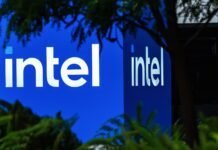Save StorySave this storySave StorySave this story
The Trump administration’s investment in Intel appears to be paying off so far, but the once-mighty chipmaker still has a long way to climb back to industry dominance.
In August, the US government announced it was converting about $9 billion in federal grants that Intel had been issued during the Biden administration into a roughly 10 percent equity stake in the company. During its third-quarter earnings on Thursday—its first financial update since Trump’s surprise investment—Intel reported that it earned $13.7 billion in revenue over the past three months, a three percent increase year-over-year. It’s the fourth consecutive quarter that Intel has beat revenue guidance.
Intel’s stock price is up more than 90 percent since it made the deal with Trump over the summer. Back then, the company’s shares were trading around $20. On the heels of its earnings report today, its stock price had risen to $38.16.
The White House announced it was investing in Intel weeks after Trump publicly called for CEO Lip-Bu Tan to resign over his alleged problematic ties to China. The president changed his stance only days later, however, after having what he described as a positive meeting with Tan.
On the earnings call, Tan said he was “honored by the trust and confidence” that President Donald Trump and Commerce Secretary Howard Lutnick had placed in him. He added that Intel was “fully committed to the Trump administration’s vision, and proudly welcomes the US as an essential partner in our efforts.”
Intel’s stronger than expected revenue suggests that global demand for x86 chips, the kind that Intel specializes in, continues to rise as the tech industry invests heavily in AI infrastructure. While GPUs, such as Nvidia’s H100s, continue to be the gold standard for training AI models, data center buildouts include a combination of GPUs and x86 CPUs, which power different AI workloads.
Intel noted in the earnings call that it hasn't been able to supply its device customers with enough older chips, which aren’t as advanced as newer generations of AI semiconductors. This is partly because consumer demand for AI-powered PCs isn’t particularly strong, so device manufacturers are still seeking older—and cheaper—chips.
Intel also reported a net income of $4.1 billion. A year ago, the company said it had more than $16 billion in losses. Under Tan’s leadership, Intel has aggressively tried to cut costs, including by laying off 15 percent of its workforce.
The last few months have been busy for Intel. Along with the Trump administration, GPU giant Nvidia and the multinational tech conglomerate Softbank also funneled money into the company in exchange for common stock. During the most recent quarter, Intel received $5.7 billion from the US government, $5 billion from Nvidia, and $2 billion from Softbank. It received an additional $5.2 billion by selling off stakes in chip maker Altera and the autonomous driving company Mobileye.
Earlier this month, Intel announced that its high-tech chip fabrication plant in Chandler, Arizona, called Fab 52, is now operational. The new chips produced at Fab 52, which are codenamed Panther Lake (for PCs) and Clearwater Forest (for data centers), will begin shipping late this year and the first half of next year, respectively.
The fab produces CPUs using a new process, or node, that could put Intel’s chip-making prowess right up there with Taiwan Semiconductor Manufacturing Company—though TSMC produces advanced chips at a much greater scale, and Intel has yet to share expected yields from Fab 52. On the call, Tan said that “Intel 18A yields are progressing at predictable rate at Fab 52 in Arizona,” but didn’t elaborate.
Analysts say that Intel still needs to secure a large customer—or ideally more than one—for its foundry chips in order to further shore up its business and boost its margins. Right now, the majority of chips made in Intel’s new fabs go into devices made by Intel’s current customers, like HP, Dell, and Lenovo.
“On the foundry side, clearly we’re engaging with multiple customers, and in building the trust of the customers you need to show yield improvements and reliability and have all of the IP they require. It’s a service industry,” Tan said on the earnings call.





























